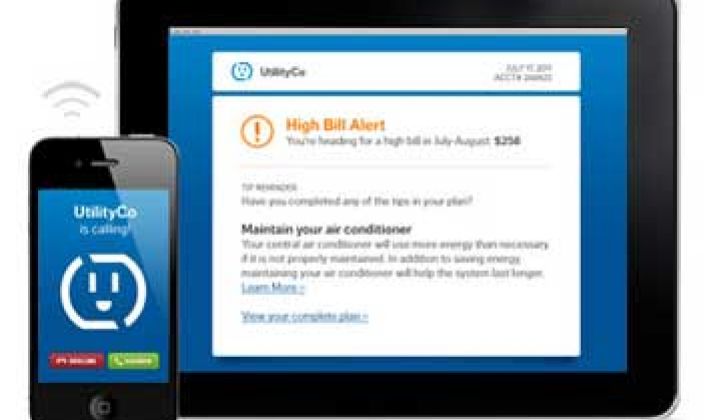Opower has its public face: the behaviorally fine-tuned, decision-tree-optimized home energy reports that it mails, emails, SMSs and web-hosts for about 75 utilities, and 15 million or so utility residential customers, across the globe.
But the Arlington, Va.-based startup has also invested pretty heavily in the back-end software and analytics that create all those customer energy web pages, accountant billing reports, utility executive dashboards and the like.
In fact, Ogi Kavazovic, Opower’s vice president of marketing and strategy, says that analytics is one of the company’s “core competencies,” developed in-house as part of the startup’s software-as-a-service platform. But like the utility industry at large, Opower has had to grow to meet the big data demands of the smart grid -- and that has led Opower to develop a new software platform, built on open-source big data tool Apache Hadoop, that is set to launch in the next two weeks or so, Kavazovic said in a Thursday interview.
While he provided few specifics, he did say that the new platform would support mobile phones and other customer-connectivity features, as well as smart thermostats and other in-home devices. Opower has demonstrated capabilities like these with smart thermostat partner Honeywell, but the two have remained mum on when they might bring their combined technologies to market.
More importantly, however, the new platform will expand Opower’s big data capabilities dramatically, Kavazovic said. “We had a huge, huge push on the back end -- we basically rewrote our code base, to be able to scale with the AMI data from across tens of millions of homes,” he said.
Opower analyzes existing home energy data, incoming smart meter data, consumer behavior data, weather data and lots of other disparate pieces of information. Then it simplifies the complex variables involved to present homeowners with a few choice efficiency tips, utility rebate offers, and other suggestions.
As smart meters come on-line, the amount and frequency of data coming into a system like that increases dramatically, Kavazovic said. Opower set up its cloud-based Hadoop computing environment in November 2011, and in June announced a partnership with Cloudera, a Hadoop software and services provider that helps manage Opower’s platform for crunching lots of unstructured data sets.
That in turn allows Opower to do all kinds of analytics it might not otherwise be able to handle at a reasonable cost or in a reasonable time, he said. One example is Opower’s ability to compare thousands of different homes’ smart meter reads to find tiny fluctuations that indicate certain homes are over-heating or over-cooling at certain thermostat set-points, he said.
Hadoop is at the core of the big data platforms of internet giants like Google and Facebook, but it’s far less common in the utility industry. Still, some smart grid systems, like phasor measurement units (PMUs) that require capturing 60 data points-per-second in perfect synchronization, require the kind of big data management capabilities it provides -- the federal Tennessee Valley Authority is building its PMU data platform on Hadoop. Recently unstealthed startup AutoGrid is also using the open-source tool to build its unstructured data platform for the smart grid.
There’s little doubt that the smart grid’s big data needs are growing. Opower, which has raised about $65 million to date, now has about 15 million homes under contract to 75 utilities, with big names including Pacific Gas & Electric, Pepco, Baltimore Gas & Electric, FirstEnergy, National Grid and Consumers Energy.
The startup has also been moving into overseas markets, with U.K. customer First Utility in 2011, with Canadian customer Nova Scotia Energy in June, and most recently with a 1.5 million-home project for EnergyAustralia. The U.K. and Australia have deregulated energy markets, where retail utilities compete to attract and retain customers. That can make high-tech tools that can connect them to their customers -- including Opower’s hosted web portals and customer management tools -- a marketing tool as well as an efficiency tool.
On the international front, Opower is also working with two other utilities in two other as-yet-unannounced countries, Kavazovic said. While he wouldn’t name the customers, he did say that one of them was in a country where English wasn’t the primary language, and that one of them has about 30 million customers across its nation’s service area -- though he added that Opower was only in pilot project status with the latter utility.
Competitors to Opower include Boulder, Colo.-based Tendril, which has more than 30 utility pilot customers and a few full-scale rollouts promised, and Aclara, whose customer web portal now runs at about 20 utilities across the U.S. Silver Spring Networks provides analytics to its utility customers, and Efficiency 2.0, a startup that provides millions of utility customers a web portal to win coupons and other prizes for energy efficiency, was bought by C3 earlier this month.
In the long run, Kavazovic said, Opower sees itself as the manager of a utility’s customer outreach program. After all, it’s already running web portals branded under utility logos that are viewed by millions of customers, as well as supporting integration to the rest of a utility’s enterprise IT system, from customer service to rate-case planning.
Indeed, a few of Opower’s utility customers are already asking the startup for application programming interfaces (APIs) to allow them to tap the analytical output from its platform, Kavazovic said. While it hasn’t made its pure analytics available to utilities that aren’t already customers yet, it’s planning to roll out a robust set of APIs for the industry at large some time next year, he added.



